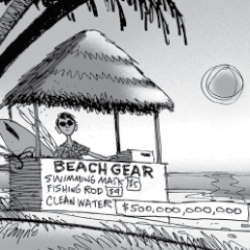
Revisions allow you to track differences between multiple versions of your content, and revert to older versions.
This issue's articles are available below.
ELI Members may login to read and download current and past issues of the Forum.
Not a member? Join now!

LEAD FEATURE The new infrastructure law offers an opportunity to holistically address the geographic nuances of climate change policy and sustainable infrastructure. Stakeholders have a responsibility to consider place-based distinctions in promoting environmental justice.
With SIDEBARS by two experts on community engagement and justice: Monica Esparza and Jonathan Skinner-Thompson.

CENTERPIECE The four basic causes of today’s planetary crises that this article focuses on are rarely addressed by most environmental professionals, who rely on the myth that technological innovation will allow endless growth on a finite planet.
With a SIDEBAR by Sparsha Saha, Harvard University.

COVER STORY Cities facing huge costs for implementing technology- based standards for storm runoff and sewage treatment are now looking beyond the letter of the federal pollution law to achieve superior water quality gains at substantially lower costs. It is time for the CWA to catch up.
With SIDEBARs by two regulators of wastewater management at the local and federal levels: Oluwole “OJ” McFoy and Andrew Sawyers.

PROFILE Stephen Ressler’s online courses portray the behind-the-scenes work of the engineer in achieving society’s goals, including environmental protection. He tells us how the profession can lead the charge to a green economy, and why policies should play a role.

THE DEBATE By regulating pollutant discharges and setting water quality standards, the Clean Water Act has led to substantially cleaner streams and lakes since its passage. Yet many challenges remain for the future of water protection. In the coming years, regulators need to address nonpoint source pollution, disproportionate pollution burdens, and climate change, among other issues. We ask experts: At year 50, how can we update the CWA to alleviate water issues over the next half-century?
Agencies Promise Tools to Shore Up Climate, Clean Energy Agenda.
Unpredictable Knock-On Effects of Hot Arctic and Melting Cryosphere.
Zoom Without Muting: Leaf Blower Bans, Restrictions Gain Traction.
Court Raises More Questions Than Answers for Practitioners.
No Longer a Major Question About the Court’s New Direction.
Sea Emergency: Climate Change, Trade Subsidies, Small Fisheries.
In an Era of Stark Major Questions, Congress Remains on the Sidelines.
Designing Energy Tax Credits to Drive Greater Emission Reductions
On the Plug-in Electric Car Movement.
See Your Colleagues' Job Changes and Accolades
On the Supreme Court's Direction.